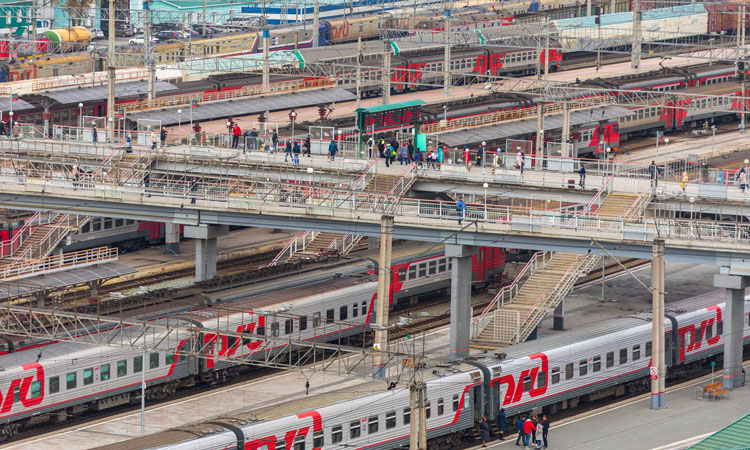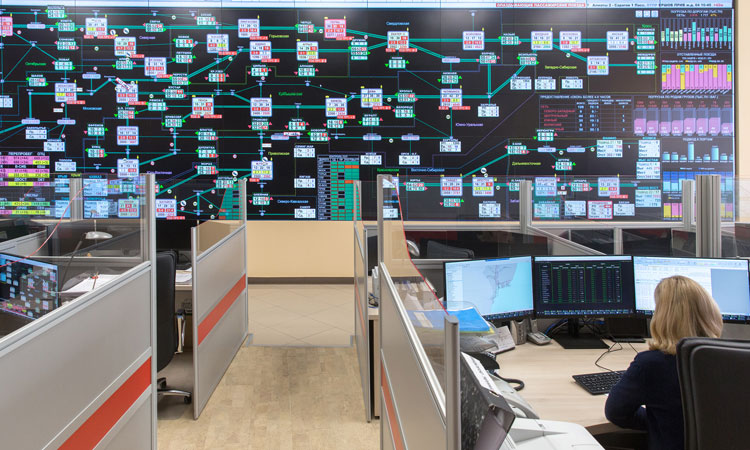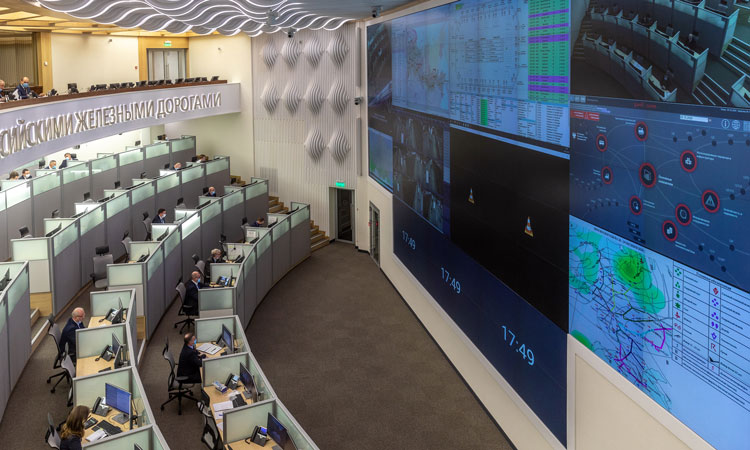The continual progress of Russian Railways’ digital transformation
Posted: 31 August 2021 | Evgeny Charkin | No comments yet
Evgeny Charkin, Deputy Managing Director, Digital Transformation and Information Technology, of Russian Railways (RZD) explains how digital technologies are at the heart of the company’s development, increasing efficiency, improving quality of services and aiding contactless interaction.


Russian railway transportation has gone through a very serious transformation over the past two decades, from being a government ministry to becoming the industry’s largest holding. We are used to working under conditions of constant changes, and today this is a big advantage we have over other companies. Clients, macroeconomics, competitors and innovations all dictate the need to be in permanent flux.
Digital Transformation Strategy
In 2019, Russian Railways (RZD) became one of the first Russian state-owned companies of its size to develop and approve its Digital Transformation Strategy at the board level.
Since then, we have gained useful experience in carrying out our Strategy, its first effects have been seen, and we have identified the areas in which we need to focus our efforts. In 2020, amid the coronavirus pandemic, we redefined our work priorities to favour projects that allow remote and contactless interactions, both within the company and with our partners and customers.
Our Digital Transformation Strategy is set in the Long-term Development Programme of RZD by 2025, which outlines the overall strategic vector for development and is linked to government documents on the digital economy.
Taking into account the scale of our business, we are solving the extremely ambitious task of optimising processes using digital technologies. In some cases, classic automation does not show any noticeable improvements. A complete reengineering of these processes and updating the regulatory documents that define them are required. The key question here is ‘what are we doing?’ We are determining the results of our changes and increasing work efficiency.
Of no less importance is our approach and methodology. Here, we are seeking a way to manage digital transformation projects and approaches to staffing, as well as managing our technology portfolio. We are also determining regulatory restrictions and building an organisational structure for managing our digital transformation. Changes in business are linked with developing technology: computing and telecommunication capacities and IT infrastructure.
Creating a digital culture
The RZD Digital Transformation Strategy defines seven digital platforms: infrastructure, transportation, cargo, passengers, traction, transport and logistics hubs, and non-production processes. The platform approach is one of the main principles by which we are changing the technological architecture of our company. At the same time, we are optimising processes and developing the necessary regulatory framework, as well as developing a digital culture.
…digital technologies are changing the transportation process. They significantly increase efficiency, reduce human error, and support specialists in making the right decisions.
On this basis, a wide range of services is being created for both external and internal clients. In total, our strategy includes more than 50 projects based on the most modern digital technologies. This number will grow as digital transformation governing bodies consider ideas, initiatives, and proposals for transforming specific areas of activity.
This approach will result in the creation of our own ecosystem: a collection of developers and business partners who use Russian Railways’ data standards and digital platforms to provide our services.
Today, there is no doubt that almost every element of rail transportation should have a serious digital component, primarily due to market requirements. Clients want to have access to information about their cargo in real-time, communicate with carriers electronically, pay in a convenient manor, and connect related modes of transport to the transportation process.
Rail’s transformation through digital technologies
First and foremost, digital technologies are changing the transportation process. They significantly increase efficiency, reduce human error, and support specialists in making the right decisions. As a result, the quality of transportation services, flexibility, and customer focus are growing.
There are a lot of ways this is happening, so here we will focus on just a few. As part of our work to create a digital twin, we get an accurate digital model of the railway with an analysis of the current state of objects and monitoring of changes. In fact, the digital twin is a cyber-physical system operating in real-time, because the trains travel around the clock. It is important that modelling external influences and management processes allows you to search for optimal solutions on the digital twin, and not on a real object.


We are working to introduce virtual and augmented reality technologies into our processes. First, this provides training and support services for line employees working at power-supply, automation, and telemechanics facilities.
One important area for the use of artificial intelligence is technical vision. The results of pilot projects at Losta and Kinel stations showed that this system makes it possible to increase the growth of the throughput of marshalling yards by reducing accidents and increasing the work rhythm.
A single integrated automated infrastructure-management system processes data on more than 25 million objects. The existing system is complemented by the Internet of Things (IoT), BIM, and big data, and the platform has already implemented a wide range of services: a digital traction substation, infrastructure lifecycle management, predictive analytics, and mobile workplaces for infrastructure workers.
Other areas of transportation digitalisation include natural language processing, recommendation services, autonomous vehicle management, software robots, and many others.
Realising the benefits
The first results and effects can be seen. For example, a prototype digital assistant to a shunting dispatcher was tested at the Chelyabinsk Main station. It analyses many factors, takes over routine operations, and enables workers to focus their energy on particularly difficult situations, such as safety hazards and malfunctions. This prototype turned out to be very successful: its predictions and recommendations reduced the average idle time of cars at the station by more than 20 per cent.
The RZD Digital Transformation Strategy defines seven digital platforms: infrastructure, transportation, cargo, passengers, traction, transport and logistics hubs, and non-production processes.
We are introducing digital technologies not just because it is a popular thing to do these days. Each idea, each initiative is carefully analysed in terms of its technological and economic feasibility. It takes effort and time, but in the end, it allows you to get a real return on your new technologies. In our development of customer services, we have focused on contactless interactions to help minimise human error and, during the pandemic, keep our customers and employees safe.
We can determine the market reactions, both in the past and this year, in the growing popularity of the Freight Transportation Electronic Trading Platform, Client’s Personal Account, and other digital-communication channels. As of today, 63 per cent of tickets for long-distance trains and 88 per cent of domestic freight traffic are issued electronically.
We have many e-document management projects, and this is the main element of modern transportation. Each project speeds up interactions, saves resources and reduces the number of errors while minimising human error.
Our legal e-document services turned out to be even more in demand during the pandemic. Over the past year, more than 21,000 contractors have used it and, in total, more than 3,800,000 e-documents have been processed. It is estimated that e-document management increases transaction speeds by at least 20 per cent.
Electronic data exchange is being developed with our foreign partners in Finland, China, Kazakhstan, and others.
Digital interactions with federal executive authorities are being set up and we have launched document exchanges through interdepartmental e-document management.
We are working with the Federal Tax Service in the tax-monitoring mode and creating several projects to develop a transportation and logistics information ecosystem with the Federal Customs Service.


Digital technologies speeding up freight
The international INTERTRAN project is aimed at creating digital services for intermodal container deliveries, and we have implemented a pilot project on the Yokohama–Vladivostok–Moscow route. The Electronic Interaction Port–Railroad unified information technology was also put together.
Using digital technologies, automating document processing, and digitalising applications have made it possible to reduce the total cargo clearance time by an average of four days, and this directly affects production efficiency and frees up working capital. We are also expanding our transportation geography with our partners in Poland, Germany, Kazakhstan and other countries.
Our blockchain and smart contracts fit right into the logic of contactless interaction. We have tested a pilot system of smart contracts in a transportation and logistics complex based on blockchain technology on the Oktyabrskaya Railway, the effects of which have been confirmed both in terms of transparency and objectivity of transportation data and digital support along the entire route. This is necessary for customers and gives us a serious competitive advantage in rail transportation.
In addition, we are working on using blockchain technology for tracking container cargoes between China and Europe with the participation of our foreign partners in China, Kazakhstan and Belarus.
Modern logistics presupposes seamless interaction between different modes of transportation. Therefore, we are developing information technologies for connections between the port stations of Russian Railways and port terminals. Since 2017, road-to-port and port-to-road technologies have been successfully implemented on the Far Eastern, Oktyabrskaya and North Caucasian railways. This solves issues of digitalising production processes at terminals, as well as data aggregation for delivery orders taking into account information about ship arrival times.
A mutual exchange between the RZD automated control system and that of the port terminal in order to plan train supplies (taking into account the cargo needed by the terminal in a specific period) makes it possible to:
- Significantly increase the volume of unloading while minimising costs
- Increase the efficiency of the port infrastructure
- Minimise downtime while waiting for the supply and cleaning of wagons
- Improve resource planning.
Information security issues are of high priority for our Digital Transformation Strategy. Every possible measure is taken to protect our company’s data, and the development of new systems is carried out taking into account all the requirements for information security from day one. The security of RZD information systems is ensured in compliance with all regulations, as well as using our own original strategies. This is ongoing work that includes interactions with the government.
This is only a small part of our digital projects, and our digital transformation is continuing.


Issue
Related topics
Big Data, Building Information Modelling (BIM), Cargo, Freight & Heavy-Haul, Digitalisation, Internet of Things (IoT), The Workforce







